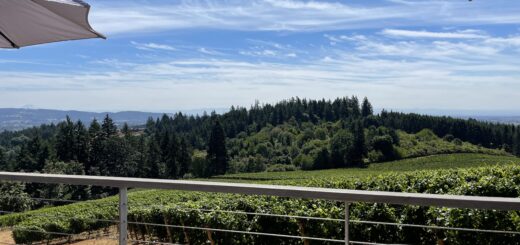Goldilocks knows what a vine needs
The more I learn about the nuances and intricacies of wine and wine making, the more I need to break it down into the simple building blocks. When you consider the final product of the wine in your glass and how it smells, tastes and finishes you may not think about its origin. But when you begin to study wine and go through a systematic assessment of wine you start to understand there are essentially five basic things that a vine needs. How you affect each of these factors leads to the unique qualities of the finished wine. You are always playing the “Goldilocks” game trying to find the “juuust right” combination in each of these elements to create a balanced wine.
Carbon Dioxide
Vines need carbon dioxide in order to combine it with water and undergo photosynthesis thus produce the glucose and oxygen needed for the plant to grow. While this is vital to making wine, it is pretty consistent across wine regions and thus we will not spend much time discussing it.
Sunlight
Sunlight is essential for photosynthesis to take place. However full sun is not needed for photosynthesis to take place. If a vine gets at least a third of full sun then photosynthesis is not adversely affected. That’s why cloudy days don’t significantly slow the ripening process while foggy days can have an adverse affect. Sunshine also increases the color pigmentation in red grapes. It also increases the level in tannins in grapes prior to véraison, the changing of color in grapes, and helps to softens the bitterness of the tannins during the ripening season.
Managing sunlight during the growing season becomes an important factor in canopy management. In a sunny environment you will want to maintain a canopy of leaves over your grapes so they do not become sunburned. This also helps to slow the ripening of the grapes and allowing the grapes to mature throughout the growing season. If you allow them to ripen to quickly you will end up with high alcohol wines with little acidity and balance. Conversely in an environment with less sun, you will want to thin the leave canopy to allow for more sunlight and thus more photosynthesis. Otherwise you will not achieve the level of sugar needed to create a balanced wine.
Heat
As we discussed sunlight affects the amount of heat a vine gets in its growing season. Heat comes from two primary things. The amount and intensity of sunlight it receives as well as the amount that is reflected from the soil. Why are wines almost currently grown between 30º and 50º latitude? If you get closer to the equator there is too much heat for vines to be successful. The will either ripen too quickly and convert that heat to too much sugar too quickly or simply shut down. Conversely if you get too far away from the equator your vines will not have enough heat for the plants to perform photosynthesis and therefore you will never ripen your fruit properly.
In terms of finished wine consider the difference between the crisp citrus and white floral notes of a Chablis or the grassy, citrus and elderberry notes of a Sancerre. Both of these are colder climate white wines. The Chablis coming from the Chardonnay grape while the Sancerre coming from Sauvignon Blanc. However, if you have Sauvignon Blanc and Chardonnay from a warmer region you are going to get an entirely new flavor profile. Sauvignon Blanc from New Zealand is going to have notes of grapefruit and tropical fruit to go along with the cut grass aromas. Chardonnay from a warm climate is going to have ripe fruit flavors of peach, papaya and pineapple flavors.
Nutrients
Nutrients are the soil particles, humus and fertilizer that feeds your vines. Vines don’t need a ton of nutrients to survive therefore most soils can be conducive. Nitrogen is a component of chlorophyl and proteins necessary for photosynthesis. Too much nitrogen can lead to excessive vegetal growth which will divert the sugars to the leaves away from the grapes. Too little nitrogen can lead to yellowing leaves and reduced vigor of the vine. In general high quality grapes are produced with a restricted supply of nitrogen but enough for growth.
Potassium is essential for vine growth as it helps regulate water uptake in the vine. Very high potassium inhibits the uptake of magnesium which can reduce yields and quality of the grapes. High levels of potassium can also lead to an over acidic grape. Too little potassium can lead to low sugar accumulation and thus poor quality yields and overall poor vine health.
Phosphorous, calcium and magnesium are also important nutrients for the vine. The presence of humus can increase the soils ability to hold nutrients. There are all types of ways to manage the nutrients in the soil from conventional to sustainable, organic to biodynamic to precision viticulture.
Water
Water might be the biggest Goldilocks of them all as you have to get this just right to have high quality grapes. If water is too plentiful in the early stages of the growing cycle it creates more shoots and leaves to grow thus creating competition for the sugars that the grapes need. A mild water stress is optimal prior to véraison as it inhibits unnecessary vegetal growth. As we get closer to harvest the right amount of water again becomes vital. Too much water often caused by rainstorms can dilute the amount of sugar in the grape when picked. In extreme cases it can even cause the skins to burst encouraging botrytis. Too little water can leave to grapes shriveling before they reach the proper ripeness.
Excessive rain can also cause problem in the early stages of the growing cycle. Damp soils are cooler causing late bud break. Rain during the flowering stage can result in uneven ripening or lower yields later in the season. Humidity also can encourage disease in the canopy by creating the environment for downy mildew and botrytis.
Another factor is how the soil retains water. Ideally vines will have to grow deep roots to search for a water source. Clay soils retain water and make it too easy for vines to access thus reducing their need to grow deeper roots. This may be advantages in areas with low or no rainfall like Jerez in Spain. However in places with more higher levels of rainfall like Hawke’s Bay in New Zealand free draining gravel soils are needed for vines to thrive.
Mid slope planting tends to be the best for water retention. The top of the slope tends to retain too little water while all the water pools at the bottom of the slope. In the middle the soil has the ability to retain what it needs and let the rest flow down the hill.
Conclusion
One of my favorite things to do is drink wine from places I have been. As you remember the location of the vineyard you can think about how hot it is there, how much sunlight and rain the it gets throughout the growing season as well as what the soil looks like. The more I learn about vineyard and wine making techniques the more you realize it is all in an effort to control these basic elements of wine making and create something juuust right for all us Goldilockses.

